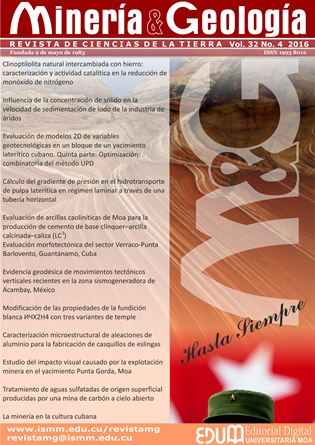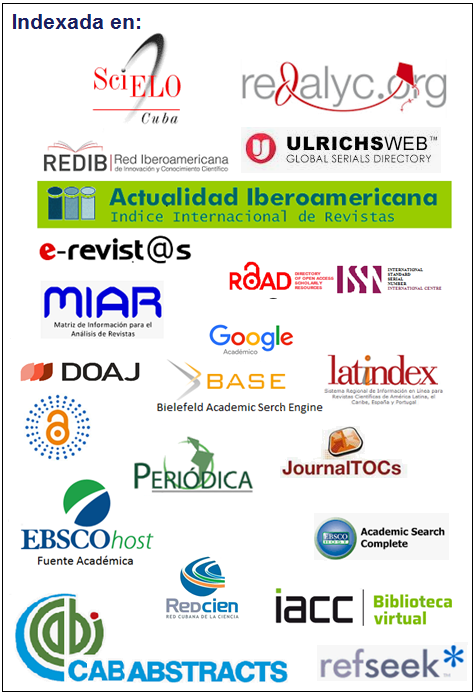Visual impact produced by mining activity in the Punta Gorda ore body, Moa
Keywords:
landscape, visual quality, impact assessment, visual basin, open-pit mining, Punta Gorda ore body.Abstract
Open-pit mining has adverse impacts on the landscape of the mining area. This article describes the visual impact resulting from surface mining activities being conducted in the Punta Gorda laterite ore body located in Moa. The implementation of the indirect method Bureau of Land Management by means of computer tools, such as Surfer 8.0, Didger 3.02, Gemcom 4.11, Autocad Civil 3d allowed the determination of visual landscape units and the main visual basins according to the method of selection used. This investigation also includes an analysis on the visual basin soil, color, texture and luminosity. Observation locations were selected based on their topographical characteristics or because of their being located in the highest altitudes. It was concluded that the visual impact of mining activities on the landscape investigated covers more than 50% of the visual basin. This research paves the way to a new field in the visual impact assessment of open-pit mining in Cuba. It constitutes a practical contribution providing information of interest on landscapes for the decision making associated with ore body management and planning and it stands out for being useful to ensure a successful mining and environmental planning of a region.Downloads
References
BARRASA-GARCÍA, S. 2010: Evaluación y cartografía de paisajes visuales en planificación ambiental. Teoría, métodos y técnicas del ordenamiento ecológico y territorial. Centro de Estudios en Geografía Humana. Michoacán, México, 221-240.
BLM (U.S.D.I., Bureau of Land Management) 1980: Visual resource management program. Div. of Recreation and Cultural Resource. Stock No.0224-011-000116-6. Government Printing Office, Washington, D.C: U.S.
CÁNCER, P. 1999: La degradación y protección del paisaje. Ediciones CÁTEDRA, Geografía Menor, Madrid, 247 p.
CEPRONÍQUEL. 2010: Proyecto de rehabilitación del yacimiento Punta Gorda. 70 p.
CONAMA. 2007: Antecedentes para analizar el paisaje en el contexto del SEIA. División de Evaluación y Seguimiento Ambiental. Área de Evaluación de Impacto Ambiental. 87 p.
CONSEJO DE EUROPA. 2000: Convenio Europeo del Paisaje. Florencia. 10 p.
CONSTITUCIÓN DE LA REPÚBLICA DE CUBA. 2003: Gaceta Oficial de la República de Cuba [en línea] edición Extraordinaria número 3 de 31 de enero de 2003. Disponible en: http://www.cubadebate.cu/cuba/constitucion-republica-cuba/
CRUZ-PÉREZ, L. & Español-Echániz, I. 2009: El paisaje. De la percepción a la gestión. Ediciones Liteam, Madrid. 202 p.
ESCRIBANO, M. 1991: El Paisaje. Ministerio de Obras Públicas y Transportes, Secretaría General Técnica, Centro de Publicaciones, Madrid, España, 198 p.
ESTÉVEZ-GONZÁLEZ, V. 2012: Calidad y fragilidad visual del paisaje: MCE, fuzzy logic y GIS. Tesis de maestría. Universidad Complutense de Madrid. 234 p.
GARCÍA-DE LA CRUZ, M.I. 2013: Procedimiento para el reemplazo de los equipos mineros. Tesis doctoral. Instituto Superior Minero Metalúrgico. Moa, 100 p.
GONZÁLEZ-BERNÁLDEZ, F. 1981: Ecología y Paisaje. Editorial Blume, Madrid, 250 p.
GONZÁLEZ-BERNÁLDEZ, F. 1985: Invitación a la ecología humana. La adaptación afectiva al entorno. Técnicos, Madrid, España, 256 p.
KARANAKOVA, R. & PANOV, Z. 2011: Methodology of Visual Impact Assessment on Surface Mines and Measures of Managing with the Visual Resource for the design of Surface Mines. XI-th National Conference with International Participation of the Open and Underwater Mining of Minerals, Varna, Bulgaria, 19-23 June. (Proceedings), 173-180.
MARTÍNEZ-VEGA, J.; MARTÍN, M. P. & ROMERO, R. 2003: Valoración del paisaje en la zona de especial protección de aves Carrizales y sotos de Aranjuez, Comunidad de Madrid. GeoFocus 3: 1-21.
MATA-OLMO, R. 2008: El paisaje. Patrimonio y recurso para el desarrollo territorial sostenible. Conocimiento y acción pública. Arbor 184(729): 155-172.
MATEO, J. 2008: Geografía de los Paisajes. Primera Parte. Paisajes naturales, Editorial Universitaria, La Habana, 191 p.
MIRAVET-SÁNCHEZ, B.; García-Rivero, A.; Salinas-Chávez, E.; Cruañas-López, E. & Remond-Noa, R. 2014. Diagnóstico Geoecológico de los paisajes de la cuenca hidrográfica Ariguanabo, Artemisa, Cuba. Ciencias de la Tierra y el Espacio 15(1): 53-66.
MOPTMA. 2004: Guía para la Elaboración de Estudios del Medio Físico. Contenido y Metodología. 254 p.
MONTOYA-AYALA, R. 1997: La fragilidad del paisaje de los Tuxtlas, Veracruz, México. En: Primera Reunión de Usuarios de IDRISI, Alcalá de Henares. 17 p.
MONTOYA-AYALA, R.; Padilla-Ramírez J. & Stanford-Camargo, S. 2003: Valoración de la calidad y fragilidad visual del paisaje en el valle de Zapotitlán de las Salinas, Puebla, (México). Boletín de la Asociación de Geógrafos Españoles 35: 123-136.
MUÑOZ-PEDREROS, A. 2004: La evaluación del paisaje: una herramienta de gestión ambiental. Revista chilena de historia natural 77(1): 139-156.
NC 93-06-101. 1987: Paisaje. Términos y Definiciones. Sistema de Normas para la Protección del Medio Ambiente. Comité Estatal de Normalización, La Habana, 15 p.
SALINAS-CHÁVEZ, E. 1991: Análisis y Evaluación de los Paisajes en la Planificación Regional en Cuba. Tesis doctoral. Universidad de la Habana. 187 p.
SALINAS-CHÁVEZ, E. & RAMÓN-PUEBLA, A. 2013: Propuesta metodológica para la delimitación semiautomatizada de unidades de paisaje de nivel local. Revista do Departamento de Geografía –Universidad de Sao Pablo 25: 1-19.
TARANCO-SEGOVIA, N. 2001: Ordenación y sostenibilidad ambiental: estudio de caso: El paisaje en la Sierra de Espadán. Concellería de Medio Ambiente de la Generalitat Valenciana. 38 p.
Published
How to Cite
Issue
Section
- Authors retain copyright and guaranteeing the right magazine to be the first publication of the work as licensed under a Creative Commons Attribution-NonCommercial that allows others to share the work with an acknowledgment of the work's authorship and initial publication in this journal.
- Authors may establish separate supplemental agreements for the exclusive distribution version of the work published in the journal (eg, place it in an institutional repository or publish it in a book), with an acknowledgment of its initial publication in this journal.
- Authors are allowed and recommended to disseminate their work through the Internet (e.g., in institutional telematic archives or on their websites) before and during the submission process, which can produce interesting exchanges and increase citations of the published work. (See The effect of open access)




